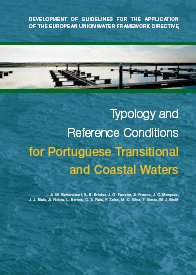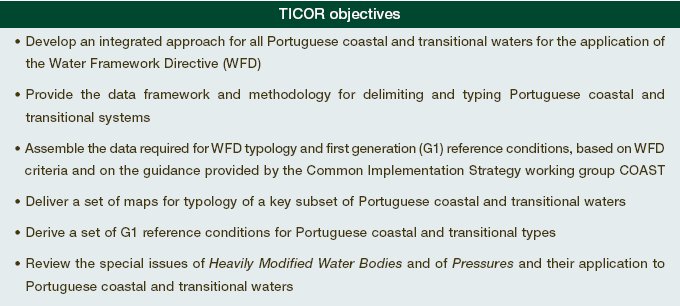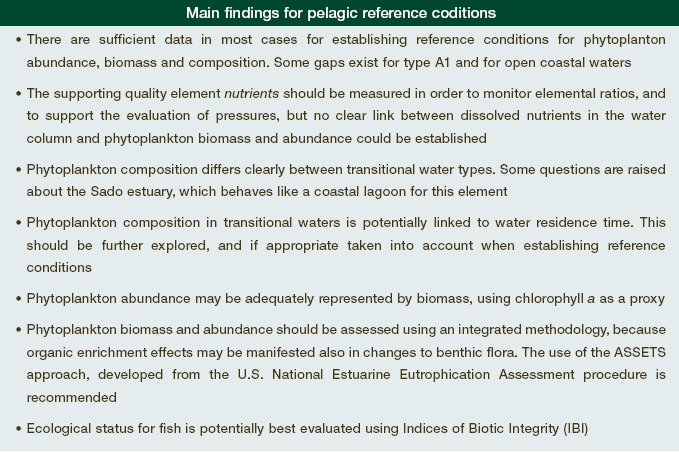
How do I get a copy of this book?
Send an email here with your postal address and TICOR in the subject.
Introduction
Portugal has a number of important estuaries, which fall under the category of transitional waters two of these, and parts of the rivers which flow into them, form the northwestern and southeastern borders with Spain. Portugal has an extensive coastal area, which delimits the country to the west and to the south.
The Typology and Reference Conditions (TICOR) study aimed to provide a framework for appropriate coastal management in Portugal, following the requirements of the Water Framework Directive. The team carrying out this work reviewed a broad range of issues, ranging from classification of different systems, division into system types, and examination of approaches to ecological quality status and the definition of reference conditions for transitional and coastal waters. The project started on June 5th 2002, and had a duration of one year.

Key outputs and findings
A summary of the key outputs and findings of TICOR are presented below.
Data
Over 600,000 records of data for Portuguese transitional and coastal waters have been archived in relational databases during the project. These are available on the internet, and contain parameters ranging from water and sediment quality to species lists, covering ten transitional and coastal waters, and in some cases spanning over seventy years. These data were the foundation for the work which has been developed, and are an important reference collection of historical information on which future monitoring and research activities may build.
Systems, Limits and Morphology
TICOR addressed ten transitional and inshore
coastal systems, as well as the coastline of continental Portugal (Figure 1). The project did
not consider the areas of Madeira and Azores. A geographic information system (GIS) was
developed for all the systems, and was used as a framework for the subsequent definition of limits,
areas and volumes.

From a total of 44 transitional or coastal systems in Portugal, about half are in class A (> 0.3 km2). The other 48% are distributed in other classes. Class D (> 1.0 km2) is the most representative of these. The systems studied in TICOR, together with their classification into transitional or coastal waters and morphological data, are shown in Figure 1.
Typology
Seven different types of transitional and coastal waters were defined for Portugal, based on the consideration that the number of types should be relatively small but should accurately reflect the existing diversity of systems (Figure 2).

Two transitional water types were defined, corresponding to estuarine systems from the northern and southern parts of Portugal. Type A2, mesotidal well-mixed estuary with irregular river discharge, is envisaged to be almost unique in the European Union, due to the combination of highly variable freshwater discharge and mesotidal regime. Additionally, two semi-enclosed coastal types were defined, as well as three open coastal types, which were judged to be sufficient to describe the entire Atlantic coastline. Of these three, type A6, mesotidal moderately exposed Atlantic coast, is considered to be unique to the European Union, because it combines colder north-east Atlantic and warmer Mediterranean influences with the dynamics of a narrow shelf.
The type names and descriptions are shown in Figure 2. The rationale for each type is explained in the Typology chapter of the TICOR book, and the areas and volumes for the different types were determined with basis on the GIS. Some results are presented also on the distribution of these morphological data among types, and a discussion of types which may potentially be common to other EU member states is made. The most likely candidate types are: A1, A3, A5 and A7.
Reference Conditions
Pelagic reference conditions
A review was carried out of the approaches that may be used for determination of ecological quality status in phytoplankton and fish, the latter quality element only for transitional waters. The relevance of the various supporting quality elements was also analysed, using relationships developed from the TICOR databases and other sources.

Benthic reference conditions
A review was carried out of the approaches that may be used for determination of ecological quality status of benthic quality elements, both for aquatic flora and fauna. A potential method for establishing a scale for reference conditions of benthic plants based on relative areal distribution and biomass of opportunistic and long-lived species is outlined.

The method needs to be refined and tested. The data collected on benthic macrofauna were used extensively to explore a number of different indices, across a range of transitional water types. Figure 3 shows a synthesis of the work carried out. A first generation approach to ecological quality status may be carried out by using a combination of appropriate indices, based on data availability.
Special Issues
Two key areas were examined in the Special Issues chapter: Heavily Modified Water Bodies and Pressure elements. For the first issue, TICOR results are based on data developed by the relevant guidance group, defining the evaluation process that should be followed for classification. The pressures guidance document was also used as a framework for discussion of this issue, the focus of the TICOR work is on the development of localised guidelines for the most relevant pressures on Portuguese transitional and coastal systems.
TICOR Products
TICOR is described in a book, which may be requested free of charge by sending an email to mena@megamar.org with your request, together with your name and address. An electronic copy is also available in pdf here.
The book is aimed at a broad audience. Scientific papers supporting the work described in this book appear below:
J.G. Ferreira, W. J. Wolff, T. C. Simas, S. B. Bricker, 2005. Does biodiversity of estuarine phytoplankton depend on hydrology?, Ecol. Modelling, 187(4) 513-523.
F. Salas, J.M. Neto, A. Borja, J.C. Marques, 2004. Evaluation of the applicability of a marine biotic index to characterize the status of estuarine ecosystems: the case of Mondego estuary (Portugal). Ecological Indicators, 4, 215-225.
A further article by Teixeira et al. is currently (2006) in press in Hydrobiologia (available soon).
TICOR Project team
|
Name |
|
| Alexandre Bettencourt (consultant) | abettencourt@mail.telepac.pt |
| Suzanne Bricker (consultant) | Suzanne.Bricker@noaa.gov |
| Joćo Gomes Ferreira (project coordinator) | joao@hoomi.com |
| Andrea Franco | andrea@ecowin.org |
| Fuensanta Salas Herrera | fuenmar@um.es |
| Joćo Carlos Marques | jcmimar@ci.uc.pt |
| Joćo Joanaz de Melo | jjm@fct.unl.pt |
| Ana Nobre | ana@salum.net |
| Laudemira Ramos (INAG coordinator) | laudemirar@inag.pt |
| Carlos Sousa Reis (consultant) | csousareis@netcabo.pt |
| Margarida Cardoso da Silva | MCSilva@lnec.pt |
| Teresa Simas | teresa@ecowin.org |
| Wim Wolff (consultant) | W.J.Wolff@rug.nl |
Document retrieval area
The documents in this section may be downloaded, and include general WFD materials, guidance documents, and the TICOR book.
Document list for TICOR in reverse chronological order - Click to open or right-click to download
| File name | Type | Date |
| CIS 2.4 COAST guidance | Adobe Acrobat Document | 15 of December 2014 |
| Ecological Indicators 2004 | Adobe Acrobat Document | 15 of December 2014 |
| MONAE book | Adobe Acrobat Document | 15 of December 2014 |
| TICOR book | Adobe Acrobat Document | 15 of December 2014 |
| Water framework directive | Adobe Acrobat Document | 15 of December 2014 |
Links
NOAA NCCOS - National Centers for Coastal Ocean Science
PERFECT - Literature database for Portuguese estuaries
ASSETS - Estuarine eutrophication assessment
Site developed by: IMAR-GEM - Institute for Marine Research - 2002-2006